Crash of a Cessna 425 Conquest in Ronkonkoma: 3 killed
Date & Time:
Dec 16, 1996 at 1840 LT
Registration:
N425EW
Survivors:
No
Schedule:
Macon – Ronkonkoma
MSN:
425-0150
YOM:
1983
Crew on board:
1
Crew fatalities:
Pax on board:
2
Pax fatalities:
Other fatalities:
Total fatalities:
3
Captain / Total hours on type:
2089.00
Circumstances:
The pilot had received clearance for the ILS Runway 6 approach and was advised that the previous landing traffic reported '...breaking out at minimums.' Radar data revealed that the airplane descended in instrument meteorological conditions to the decision height altitude of 294 feet, approximately 3 miles from the missed approach point. The pilot did not perform the missed approach procedure. The airplane leveled off and continued at or below decision height altitude for approximately 28 seconds, traveling a distance of approximately 1 mile. Four low altitude alerts appeared on the tower controller's display. The controller stated he withheld the alert because '...it was a critical phase of flight and the aircraft appeared to be climbing...' The airplane collided with trees and terrain approximately 1.5 miles from the approach end of the landing runway.
Probable cause:
The pilot's early descent to decision height and his failure to perform the missed approach procedure. A factor was the failure of air traffic control to issue a safety advisory.
Final Report:







